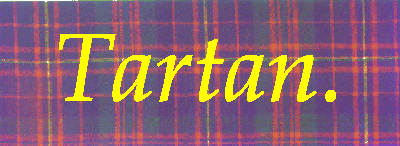

Despite all the myths you might have heard, the history of Tartans as they are known now is actually quite short. Tartan as an identification of Clan or military unit only dates back to the beginning of the 18th. Century. The raising of the last of the Highland Independant Companies about 1725 and their later forming into what is now the Black Watch Regiment seems to mark the beginning of any attempt to standardise the Tartan worn. Before this time it seems that any suitable cloth that could be obtained was acceptable, and that identification was usually marked by a badge or hackle on the bonnet.
The idea of each Clan having it's own specific tartan seems to have begun more as a marketing ploy by the large weaving firms than anything else. What this means is that anyone at all is entitled to wear any tartan they like the look of, regardless of what their name is. All those lists of which name entitles you to wear which tartan are therefore just for fun - but if you are lucky enough to match your name to a tartan you like then enjoy it!
The origins of modern Highland dress seem to date from the early 1600's and come from the "feileadh mor"- the big kilt - which consisted of a width of cloth several yards in length, this was used for sleeping in. To wear this, the highlander would put his belt on the ground with the cloth on top, gather the material in pleats, leaving enough unpleated to cover the front of the body. He would then lie on the cloth and bring the unpleated cloth across his body, fastening it in place with the belt. This then resembled the present day kilt and the remainder of the cloth could be gathered up and secured under the belt or around the shoulders depending on the weather and how much freedom of movement he required. Sometime around the middle of the 18th. Century the "feileadh beg"- the little kilt - became popular as a neater appearance could be achieved by sewing in the pleats permanently and the bulk of the plaid could be done away with. By the way, plaid in Gaelic means a blanket, not tartan or check as it is often used nowadays.


